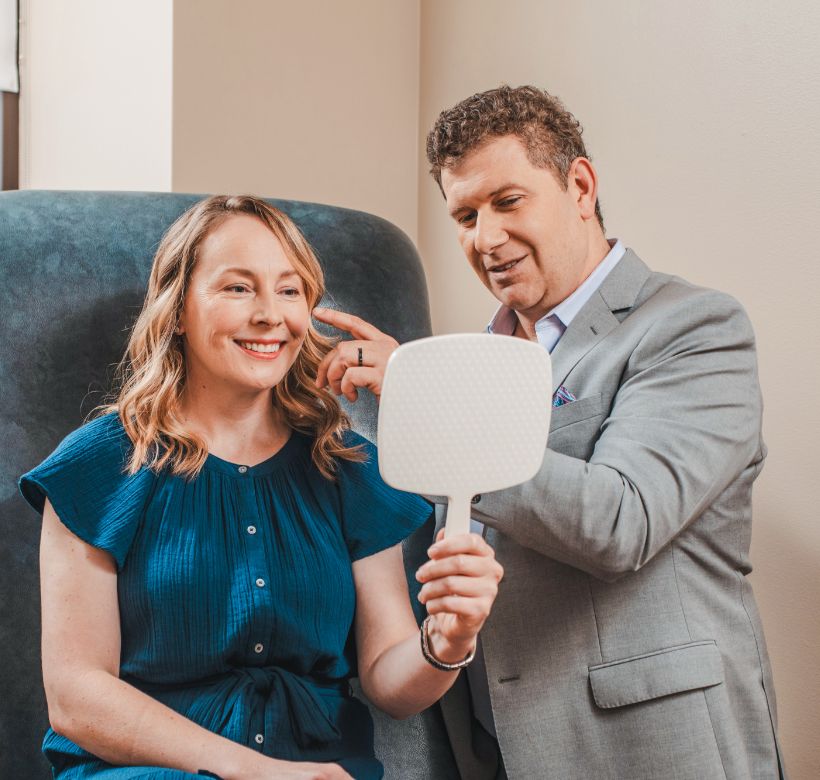Brow Lift
Brow lift surgery, also known as a forehead lift, raises the eyebrows and smooths wrinkles in the upper ⅓ of the face. This procedure removes excess skin and tightens the forehead tissues to restore a rejuvenated appearance in the forehead, eyebrow, and even upper eyelids.
Get In Touch
Benefits of a Brow Lift
Removes Forehead Wrinkles
Horizontal creases across the forehead are softened to reveal smooth, youthful skin above the eyebrows.
Corrects Frown Lines
Vertical furrows between the brows, known as “frown” or “11” lines, may be softened to achieve a more cheerful facial appearance.
Rejuvenates The Eyes
“Ptotic” or drooping brows that hang over the eyes may make one appear tired or even angry. With a brow lift, one can project a more alert, friendly and well-rested appearance.
Improves Line of Sight
Drooping of the brow may contribute to the accumulation of excess upper eyelid skin which may, in extreme cases, impair one’s vision. A brow lift, with or without upper eyelid surgery, may improve one’s field of vision.
How do I know when I’m ready for a brow lift?
Ideal brow lift candidates often demonstrate some or all of the following features:
- Extra skin of the upper eyelid which may even rest on the eyelashes (hooding)
- Deep, vertical furrows between the eyebrows (“11” lines)
- Deep horizontal lines of the forehead in repose
- Appearing tired even when well-rested, or appearing older than one’s actual age
- An annoyed or austere appearance in repose
Types of Brow Lifts
Endoscopic
- Uses 3-5 small forehead incisions, resulting in minimal scarring hidden within the hairline
- Uses an endoscope (thin tube with a camera and light attached) for the surgeon to see and modify the internal structures
- Allows permanent weakening of the muscles between the eyes which cause vertical “frown” or “11” lines in selected patients
- May not be appropriate for those patients with large amounts of extra skin
Hairline
- Uses a large incision hidden along or within the hairline above the forehead
- Allows permanent weakening of the muscles between the eyes which cause vertical “frown” or “11” lines in selected patients
- Permits the removal of large amounts of extra skin
- May permit limited advancement of a receded hairline
Lateral Subcutaneous
- Uses 2 medium-sized incisions along or within the hairline above the forehead
- Does not permit permanent weakening of the muscles between the eyes which cause vertical “frown” or “11” lines
- Reserved for patients with dropping of the lateral brow, or brow nearest the temples
- May be performed in the office under local anesthesia only
Direct
- Reserved primarily for men who are bald or with a receding hairline
- Incisions are placed directly above the eyebrows
- May be performed in the office under local anesthesia only
How Are Brow Lifting and Blepharoplasty Related?
The brow skin seamlessly blends into the upper eyelid skin just below the eyebrows, and any ptosis (drooping) of the brow may affect the appearance of the upper eyelid. Often what patients see as excess skin of the upper eyelid may actually be a result of aging changes in the brow which is why these areas must be examined together in order to develop an individualized surgical plan.
Q. How do I determine which brow lift technique is best for me?
A. Dr. Gougoutas will review all brow lifting options with you. The procedure(s) recommended will take into consideration your individual goals, anatomy and recovery.
Q. What procedures are commonly combined with brow lift surgery?
A. Browlift surgery may be performed as a stand-alone procedure or may be combined with an upper / lower blepharoplasty (eyelid surgery). A brow lift is also frequently performed as part of a facelift procedure.
Q. Can I have a brow lift if I recently had botox?
A. Botox temporarily paralyzes the muscles of facial expression and may alter one’s true brow position. It is strongly recommended that you allow all Botox to wear off (3-4 months) before being evaluated and / or treated for a brow lift procedure.
Q. Will I require Botox after my brow lift?
A. “Ptosis” or drooping of the brow is a result of the mechanical forces generated by some of the muscles of facial expression. If these muscles are not weakened surgically, or with Botox, they will eventually reverse the effects of any brow lifting procedure. It is therefore recommended that you keep up with regular Botox injections following a brow lift procedure. Doing so will give you the longest-lasting result.
Q. What is the time frame for recovery after a brow lift?
A. You will be advised to sleep with your back and head elevated for the first 5-7 days after your procedure. Non-strenuous activities of daily living may be performed during this time, though strenuous activity / exercise should be avoided. Most patients can return to work 1 week after surgery.
